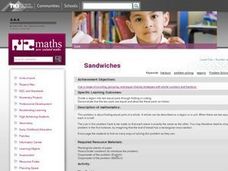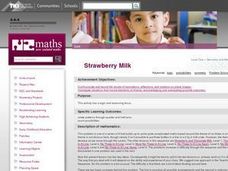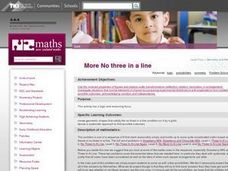Curated OER
World War II Memories
Fifth graders utilize primary sources provided to formulate questions to prepare for an interview. Veterans and civilians who lived during World War II are interviewed by students and their work displayed on a web site.
Curated OER
Rocky Observations
Students examine two images of rocks, make their own observations of individual rocks through drawing, and explain how the same observation skills can be used in the study of geology.
Curated OER
Express Yourself: Make Art From Your Ideas
Learners analyze and discuss various sculptures by the artist Andrea Arroyo. They discuss ways artists use symbols to express abstract ideas, design and create a plasticine plaque, and write a journal response.
Curated OER
"Slice of Pi with Neo-Excel"
Students explore diameter, radius, and circumference. They define radius, diameter, and circumference on an online dictionary, identify objects in the room with a radius and a diameter, and calculate the radius and diameter of various...
Curated OER
How Does Radon Get In?
Students examine the potential sources of radon entry into homes. They compute the surface area for various objects, create a sketch of their home, calculate the ratio of air leaks to the outside surface area, and conduct a radon audit...
Curated OER
Anastasia-Dead or Alive
Students complete an investigative activity that requires them to use precise observational skills. They observe a partner's ear recording pertinent data so that they can make a positive identification. They identify the teacher chosen...
Curated OER
LEGO Mini-Golf
Students work together in teams to build a LEGO golf course. They build holes with sensors on them for the golf balls. They answer questions about their project to end the lesson plan.
Curated OER
The Role Of Japanese Women
Pupils consider the role of women in upper-class Japanese society through the reading of a folktale and the study of Japanese art images. The lesson emphasizes small, cooperative learning groups.
Curated OER
Hanging Scrolls
Students explore prospective content for art, then select and use appropriate
subjects, symbols, and ideas to make art meaningful in this lesson suited for upper-elementary and middle level classrooms.
Curated OER
Identify That Culture
Students view various types of artwork and try to identify the culture being represented. Using a worksheet, they answer questions based on the artwork and the artist's use of color and technique. They research the artist's country of...
Curated OER
Japan: New Year's Day
Students discover how New Year's Day is celebrated in Japan. In groups, they create their own versions of Japanese kites using materials available to them in the classroom. They discover the signifigance of the kites to their culture and...
Curated OER
Jumping Explorations
Students work with a partner to follow the pathway-jumping in the different suggested ways. They listen to music to rotate from station to station. Students their favorite stations and levels of difficulty. They discuss the use of...
Curated OER
Wildfire: Friend or foe?
Learners explore positive and negative effects of wildfire and analyze positions on fire management. They conduct library research to uncover as much about wildfires and prescribed burns as they can. Students participate in a role-play...
Curated OER
Japanese Abstract Wind Sock
Students create Abstract Wind Socks using brown paper bags, markers, kite string, and basic art supplies in this Art lesson for the elementary classroom. Abstract concepts are emphasized and it is recommended to only use primary colors.
Curated OER
Exploring Alaska Foilage In Russian
Seventh graders investigate the concepts of how plants are part of daily culture in Russia. The skills of naming different plants is practiced. Students take a survey of the nature that is found in the area in which they live. This is...
Curated OER
The Cinquain
Students explore writing a cinquain. Students engage in a pantomime experience. They observe and describe bubbles. Students compose a cinquain and illustrate their work with bubble art.
Curated OER
The Truth About Triangles and Squares
Fourth graders investigate the patterns associated with both triangular and square numbers. They use counters as manipulatives to depict the numbers as needed but focus on problem solving using mental math techniques.
Curated OER
Location, Location
Third graders draw and interpret simple scale maps, use maps to move around efficiently or plans to propose actions. They use of a compass to specify and find directions. They display and discuss a map of the local region.
Curated OER
Around We Go
Fourth graders investigate a range of circles, each with a different radius, diameter and circumference and assemble this information in their search for relationships.The measurement of circles and the relationships to be found within...
Curated OER
Houses
Third graders use a number of problem solving strategies in this unit of lessons. They determine how to draw and model three-dimensional objects, use co-ordinate systems, determine probability of events, and identify paths of simple...
Curated OER
Sandwiches
Young scholars are introduced to the problem by thinking of all the ways 2 of their classmates could share a peanut butter sandwich. In pairs, students work describing their ideas. They then keep a record of all the different ways they...
Curated OER
Strawberry Milk
Students work in groups or alone to solve the problem. They use a systematic approach to get all possible answers. They report back to the class with solutions. They may extend their studying using a crate with room for 9 bottles.
Curated OER
More No-Three-In-A-Line
Fourth graders read Mary's problem and make sure that they examine it.
After some discussion, let the class work on the problem in their groups.
They then take turns in putting a picture of their arrangement on the board.
Curated OER
Peter's String
Students are introduced to the math problem and consider how they could approach it. In pairs, students investigate Peter's conjecture in any way they see fit. They then share their answers with the class.























